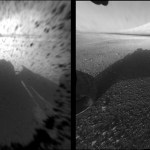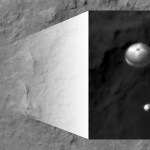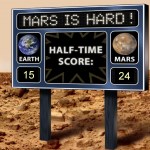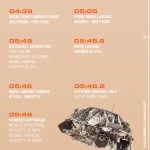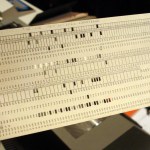Cosmos
Remember the GRAIL mission? At the beginning of the year, two satellites, named Ebb and Flow, arrived at the Moon and fell into a parallel orbit. There is an instrument on board that very precisely determines the distance between the two space craft, said to be about the size of a typical washing machine. As the craft circle the Moon in an orbit that takes them all over the place, the exact distance between them changes as a result of differential gravitational forces that are in turn caused by the details of the shape of the Moon below them. Thus, the precise measurements of distance…
The "Next Media" animation company used to send me several animations a week (a few a day for a while) but then they were bought out by a major media outlet (can't remember which one) so most of the emails I get from them now are about how great they are, rather than providing much current content. But today I got a not-very-current animation that seems pretty good and I thought you might like it, of the Mars Curiosity landing and field research:
Today, NASA did something never before done, and well, not all that impressive.
Charles Bolden of NASA spoke some words into a microscope, and this voice stream was sent to the Curiosity Rover on Mars, which then sent it back. Hey, I just spent the last 15 minutes swapping monitors around on my computers, and those monitors had cables that had been secured with cable ties and that ran through conduits and stuff. I’m thinking what I did was harder.
According to NASA, Bolden said:
The knowledge we hope to gain from our observation and analysis of Gale Crater will tell us much about the…
Here's the last few news reports:
August 21:
NASA's Curiosity Studies Mars Surroundings, Nears Drive
NASA's Mars rover Curiosity has been investigating the Martian weather around it and the soil beneath it, as its controllers prepare for the car-size vehicle's first drive on Mars.
The rover's weather station, provided by Spain, checks air temperature, ground temperature, air pressure, wind and other variables every hour at the landing site in Gale Crater. On a typical Martian day, or "sol," based on measurements so far in the two-week old mission, air temperatures swing from 28 degrees to…
Never mind the heat shield, the parachute, the thruster-guided landing, all of that. Curiosity went to Mars to carry out experiments using Big Science Gear and now it is confirmed that at least one set of gear works!
The method is laser-induced breakdown spectroscopy, in which very high power but short burst laser light is focused on a thing, and the matter the thing is made up of is drastically altered in such a way that it gives of a signal that can be picked up by instruments also pointed at the thing, to produce a spectrosopic signature.
There is no useful analysis of the data yet,…
The Angry Red Planet just gut a little angrier:
This sequence of images shows the heat shield from NASA's Mars Science Laboratory hitting the ground on Mars and raising a cloud of dust.
From NASA
NASA did an amazing thing a few days ago, landing a big giant amazing Science Robot on the Angry Red Planet, Mars. But to get to that point, to have The Ultimate Omelette, as it were, you've got to break a few eggs.
Here is what an egg looks like when NASA breaks it:
It doesn't just sit there and burn...it keeps blowing up and stuff, so you may want to watch the whole video if you missed the Fourth of July.
This is/was the Morpheus Lander.
Morpheus is a vertical test bed vehicle demonstrating new green propellant propulsion systems and autonomous landing and hazard detection technology.…
A whole bunch of photographs rom Mars have bee posted by NASA, here. I thought the following one was pretty cool because it shows how accommodating the Martians are, cleaning the dust off the lens and all.
This image comparison shows a view through a Hazard-Avoidance camera on NASA's Curiosity rover before and after the clear dust cover was removed. Both images were taken by a camera at the front of the rover. Mount Sharp, the mission's ultimate destination, looms ahead. The view on the left, with the dust cover on, is one quarter of full resolution, while the view on the right is full…
Curiosity landed on Mars last night (I assume you were watching). Well, the High Resolution Imaging Science Experiment on the Mars Reconnaissance Orbiter managed to take a picture of Curiosity with its parachute! This is so cool. Look:
NASA's Curiosity rover and its parachute were spotted by NASA's Mars Reconnaissance Orbiter as Curiosity descended to the surface on Aug. 5 PDT (Aug. 6 EDT). Image Credit: NASA/JPL-Caltech/Univ. of Arizona
How cool is that???? More details here form NASA.
You can watch along with NASA and see briefings and stuff on Curiosity Cam. The Exploratorium also has a page with a web case and various videos.
In case you haven't seen the Seven Minutes of Terror video, here it is:
Updates and a countdown clock will be found here on the NASA site.
This just in:
Curiosity Closes in on its New 'Home'
Sat, 04 Aug 2012 06:20:24 PM CDT
With Mars looming ever larger in front of it, NASA's Mars Science Laboratory spacecraft and its Curiosity rover are in the final stages of preparing for entry, descent and landing on the Red Planet at 10:31 p.m. PDT Aug. 5 (1:31 a.m. EDT Aug. 6). Curiosity remains in good health with all systems operating as expected. Today, the flight team uplinked and confirmed commands to make minor corrections to the spacecraft's navigation reference point parameters. This afternoon, as part of the onboard sequence of…
Caption from NASA: "This artist's scoreboard displays a fictional game between Mars and Earth, with Mars in the lead. It refers to the success rate of sending missions to Mars, both as orbiters and landers. Of the previous 39 missions targeted for Mars from around the world, 15 have been successes and 24 failures. For baseball fans, that's a batting average of .385."
NASA acknowledges the fact that most missions to Mars fail. The rocket goes off course or crashes, or the device lands broken, or works for a while then stops.
According to the latest press release, which has some interesting…
The Mars Science Laboratory Mission has piles of cool equipment on board Curiosity Rover, which is closing in on Mars as we speak. The landing is expected to be next Sunday/Monday, 10:31 p.m. Aug. 5 PDT (1:31 a.m. Aug. 6 EDT, 05:31 Aug. 6 Universal Time) plus or minus a minute.. But not really, because the event is happening a it far away in spacetime; those are the times that the signals from Mars will arrive on the planet Earth, about 13.8 minutes after the event has happened. The mission is expected to last one Martian year, which is close to two Earth years. The weather at the landing…
In just a few days, NASA will land one of the more amazing pieces of equipment ever sent into outer space on the Angry Red Planet. On August 5th, at about 10:31 Pacific Time, Curiosity will land on the surface of mars in one of the more spectacularly complex space engineering feats ever attempted. You will not want to miss this.
But before that, starting on Thursday, August 2nd, there will be a series of briefs and press reports that are generally open to the public and that may be quite interesting. There is a schedule, and links, HERE at NASA's JPL site.
Curiosity Rover is now tweeting its stuff. Things are going to get pretty exciting over the next few days as the space ship comes in for a landing on the Planet Mars. Meanwhile, the Mars Orbiter has made positional adjustments that will facilitate sending information back about the 15 minutes of terror.
NASA's Mars Odyssey spacecraft has successfully adjusted its orbital location to be in a better position to provide prompt confirmation of the August landing of the Curiosity rover.
NASA's Mars Science Laboratory spacecraft carrying Curiosity can send limited information directly to Earth as…
Dr. Sally Ride is reported to have died today after a long battle with cancer. She was 61. Ride was the first American woman to go into outer space, and the youngest at the time, at age 32. She was also a pioneer in STEM promotion, and a prolific author.
You know what I'm talking about. Here's the video:
The Eagle has landed. Holy crap. Excellent driving. Neil.
I love that Armstrong checks to see if it will be possible to get back up the ladder in his space suit before stepping off. Good move. That would have been...interesting...if they could only step onto the moon and not step off of the moon.
That was July 20th, 1969. Where were you? I was in China. You can see me in the video at about 9:10.
Only kidding. I was in Albany, NY glued to the TV. I remember the rug I was sitting on. I remember who was in the room. I remember…
An exoplanet smaller than the Earth may have been identified in some far away solar system.
Astronomers using NASA's Spitzer Space Telescope have detected what they believe is a planet two-thirds the size of Earth. The exoplanet candidate, called UCF-1.01, is located a mere 33 light-years away, making it possibly the nearest world to our solar system that is smaller than our home planet.
Exoplanets circle stars beyond our sun. Only a handful smaller than Earth have been found so far. Spitzer has performed transit studies on known exoplanets, but UCF-1.01 is the first ever identified with…
Before getting into this, I just want to give you the best quote about physics from a physicist I've seen in a long time. In describing the phenomenon we are discussing here, JPL scientist Slava Turyshev says, "The effect is something like when you're driving a car and the photons from your headlights are pushing you backward."
I know, right? I hate when that happens!
Anyway, here's the story. Pioneer 10 and 11 are space ships that were launched before most of you were born, in 1972 and 1973. They visited a bunch of places in the solar system, but are now heading out of our solar system…
The NASA Curiosity Rover will land on August 5th. NASA has provided a way to follow along with the show, using a special web based plugin which is set up for Mac and Windows, but not Linux.
As NASA's Mars Rover Curiosity prepares to land on Mars, public audiences worldwide can take their own readiness steps to share in the adventure. Landing is scheduled for about 10:31 a.m. PDT on Aug. 5 (1:31 a.m. EDT on Aug. 6), at mission control inside NASA's Jet Propulsion Laboratory, Pasadena, Calif.
Martian fans can help NASA test-drive a new 3-D interactive experience that will allow the public…
